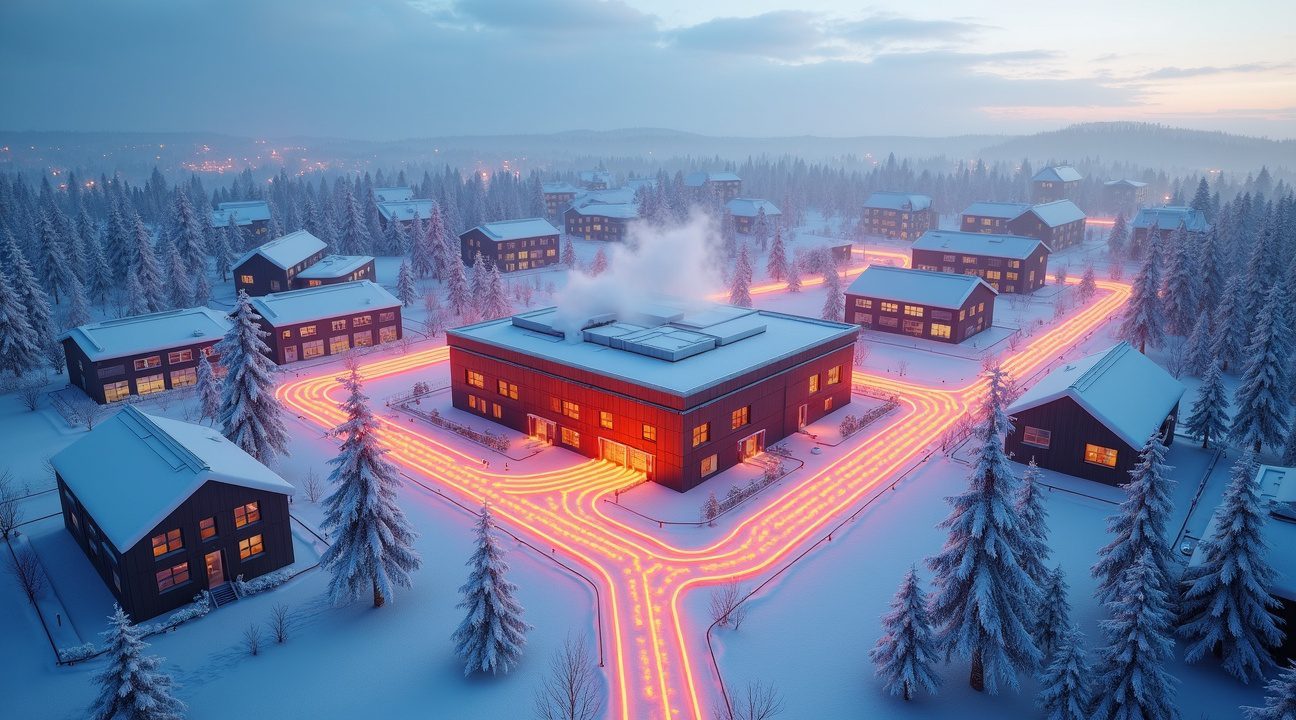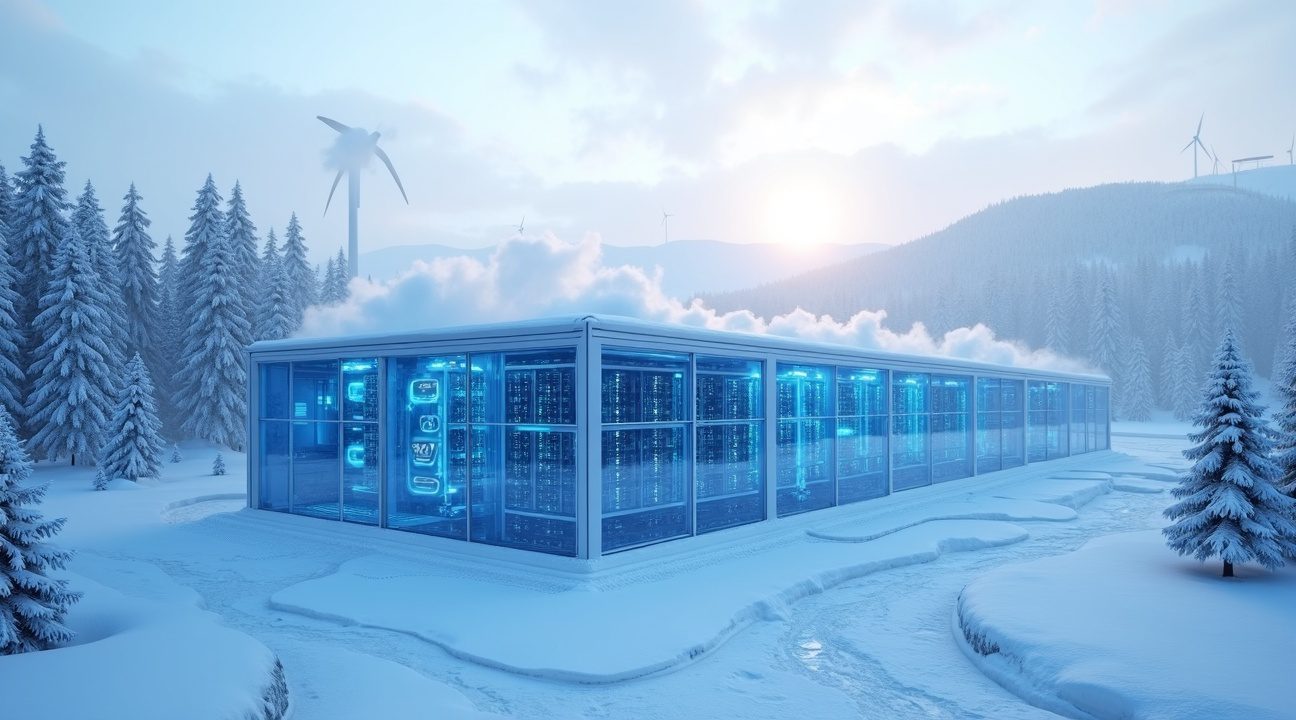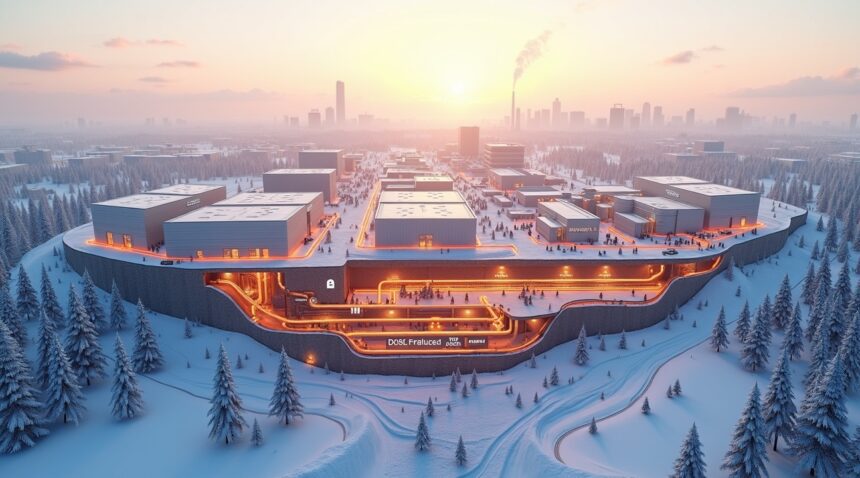Finland has revolutionized energy efficiency by repurposing the vast heat output from its underground data centers, which collectively generate 300 MW of waste heat each year—enough to power entire cities.
Transforming Digital Waste into Community Energy
Rather than letting this thermal byproduct escape into the environment through conventional cooling systems, Finnish operators innovatively reroute it using advanced heat recovery technology. This heat is then integrated into Finland’s extensive district heating network, turning what was once waste into a clean and valuable energy source for communities.
Key Takeaways
- Finnish data centers produce approximately 300 MW of waste heat annually, translating to 2 TWh of potential recoverable thermal energy, although only 200 GWh is currently utilized.
- Microsoft’s Espoo facility leads the world’s largest data center heat recovery initiative, using CO₂-based heat pumps to meet up to 40% of the city’s heating needs from server waste heat.
- Finland’s established district heating grid provides a seamless foundation for integrating waste heat without the need for major new infrastructure developments.
- With Power Usage Effectiveness (PUE) ratings between 1.03 and 1.20, Finnish data centers outperform the global average of 1.57 by leveraging Arctic temperatures to minimize cooling demands.
- Finland has dramatically cut emissions from district heating by 82% since 2003, and by 24% just between 2022-2023, through the integration of recovered data heat and renewable technologies.
A Model for Sustainable Digital Infrastructure
By combining forward-thinking infrastructure with environmental responsibility, Finland sets a global benchmark for sustainable energy practices in the digital age. Their approach not only maximizes efficiency but also aligns with broader climate goals—a model other nations may soon follow.
How Finnish Data Centers Generate 300 MW of Waste Heat That Could Power Entire Cities
Finland has established itself as a major hub for data center operations, hosting some of the world’s most significant computing facilities. Google’s Hamina facility, Telia Pitäjänmäki, and CSC Colocation Data Centers represent just a fraction of the impressive infrastructure that has transformed the country into a digital powerhouse. These massive installations, both underground and above-ground, create an unprecedented opportunity for energy recovery that most nations haven’t fully explored.
Scale and Power Consumption of Finnish Data Centers
Hyperscale facilities dominate Finland’s data center landscape, with individual sites consuming between 50 and 300 megawatts of electrical power. Mid-sized operations typically require between 0.5 and 5 MW, creating a diverse ecosystem of computational infrastructure. I’ve observed how these facilities operate continuously, processing millions of transactions and calculations every second while maintaining critical temperature thresholds.
The collective power consumption across Finland’s data center network generates approximately 300 MW of waste heat annually. This figure represents an enormous untapped resource that could fundamentally change how cities approach their heating needs. For context, this amount of thermal energy could theoretically supply district heating for several medium-sized Finnish cities simultaneously.
The Untapped Potential of Waste Heat Recovery
Technical assessments indicate that Finnish data centers possess the potential to provide up to 2 terawatt-hours (TWh) of recoverable waste heat per year. Currently, only around 200 gigawatt-hours (GWh) are being captured and utilized effectively. This gap between potential and actual utilization represents one of the most significant missed opportunities in sustainable energy management.
Data centers must continuously expel large volumes of excess heat to prevent equipment failure and maintain optimal operating conditions. Traditional cooling systems simply discharge this thermal energy into the atmosphere, treating valuable heat as an unwanted byproduct. I find it remarkable that such a straightforward concept – capturing waste heat rather than discarding it – remains underutilized across the industry.
Several factors contribute to this underutilization, including:
- Infrastructure costs
- Regulatory frameworks
- Coordination challenges between data center operators and district heating networks
Many facilities were designed before waste heat recovery became a priority, making retrofitting more complex and expensive than incorporating these systems during initial construction phases.
The temperature of data center waste heat typically ranges between 25–35°C, which requires heat pump technology to reach the 80–90°C needed for effective district heating systems. Despite this additional processing step, the energy efficiency gains remain substantial when compared to traditional heating methods.
Modern AI systems and advanced computing applications are driving even higher heat generation rates as processors become more powerful and energy-intensive. This trend suggests that waste heat availability will continue growing, making recovery systems increasingly valuable for Finnish communities.
Finland’s climate provides ideal conditions for waste heat utilization, with heating demand spanning approximately eight months annually. Unlike warmer regions where cooling dominates energy consumption, Finnish data centers can contribute meaningfully to residential and commercial heating requirements throughout extended winter periods.
The economic implications extend beyond energy savings. Successful implementation of waste heat recovery systems could:
- Reduce operational costs for data center operators
- Generate revenue streams through heat sales to district heating networks
- Enhance environmental sustainability efforts
This creates win-win scenarios that benefit both the technology sector and local communities seeking sustainable heating alternatives.
Current utilization rates suggest significant room for expansion, particularly as newer facilities incorporate waste heat recovery from the design phase. Gaming studios and streaming services continue establishing data centers in Finland, presenting fresh opportunities to implement comprehensive heat recovery systems that maximize the value of computational waste heat.
Microsoft’s Espoo Project Will Heat 40% of an Entire City Using Server Heat
Microsoft is transforming how cities approach sustainable heating through its groundbreaking project in Espoo, Finland. This initiative represents the world’s largest data center heat recovery program, demonstrating how server waste heat can power entire communities. The project captures thermal energy generated by thousands of servers and redirects it into the city’s district heating network, potentially supplying up to 40% of Espoo’s local heating demand.
Revolutionary Heat Capture Technology in Finnish Cities
Finnish cities like Mäntsälä and Espoo have become pioneers in harvesting data center waste heat for residential and commercial heating. These massive underground facilities generate continuous thermal energy that traditionally gets expelled into the atmosphere through cooling systems. Instead of allowing this valuable resource to escape, specialized energy centers now capture and process the heat through sophisticated transfer mechanisms.
The integration process relies heavily on CO₂-based heat pumps, which efficiently extract thermal energy from server cooling systems and elevate it to temperatures suitable for district heating networks. These heat pumps operate with remarkable efficiency, creating a seamless bridge between digital infrastructure and urban heating requirements. The technology transforms what was once considered waste into a reliable energy source that can warm thousands of homes throughout the year.
Environmental Impact and Carbon Footprint Reduction
This innovative approach significantly reduces the carbon footprint of traditional district heating systems by decreasing dependence on fossil-fueled boilers. Data centers operate continuously, providing a consistent heat source that complements renewable energy initiatives. The environmental benefits extend beyond carbon reduction, as this system eliminates the need for additional heating infrastructure while maximizing existing digital investments.
The success in Espoo has attracted international attention, with other technology companies exploring similar partnerships in Finland and beyond. This model demonstrates how AI technologies and digital infrastructure can contribute positively to sustainable urban development. The project showcases a circular economy approach where technological advancement directly benefits environmental conservation.
Microsoft’s Espoo initiative sets a new standard for responsible data center operations, proving that large-scale digital infrastructure can serve dual purposes without compromising performance. The system operates transparently alongside normal server operations, with heating capture occurring through existing cooling processes. This seamless integration means data center performance remains unaffected while providing substantial community benefits.
The financial implications are equally compelling, as cities reduce heating costs while technology companies create additional value from their infrastructure investments. The partnership model between Microsoft and Espoo establishes a framework that other municipalities can adapt for their local conditions. This collaboration demonstrates how public-private partnerships can address climate challenges while supporting technological advancement.
Finnish expertise in district heating systems has been crucial to the project’s success. The country’s existing heating infrastructure provided an ideal foundation for integrating data center thermal energy. Finland’s cold climate creates year-round demand for heating, making server waste heat a valuable and consistent resource for urban energy needs.
The scalability of this approach suggests similar projects could emerge in other Nordic countries and cold climate regions worldwide. Technology companies are increasingly recognizing the value proposition of heat recovery systems, both for environmental responsibility and operational efficiency. The Espoo project proves that massive data center operations can contribute positively to local communities while maintaining their primary digital service functions.
Energy centers equipped with advanced monitoring systems ensure optimal heat transfer efficiency throughout varying seasonal demands. The technology adapts automatically to heating requirements, maximizing thermal energy utilization while maintaining consistent data center temperatures. This intelligent system management creates a sustainable heating solution that operates independently of traditional energy grid fluctuations.

Why Finland’s Underground Heating Network Makes This Revolutionary System Possible
Finland’s district heating system creates the perfect foundation for capturing and redistributing waste heat from data centers. This infrastructure already heats 45% of residential, commercial, and public structures across the country as of 2023, making it one of the most comprehensive heating networks in the world.
Finland’s Existing Heating Infrastructure Creates Unique Opportunities
The country’s district heating network has been developing for decades, reaching remarkable penetration rates. Back in 2015, this system provided heating for 90% of apartment buildings, demonstrating how deeply integrated it had become in urban planning. Industrial facilities relied on district heating for 30% of their heating needs, while over 60% of other structures also connected to this centralized system.
Finland’s underground heating network operates through a sophisticated distribution system that carries hot water or steam through insulated pipes buried beneath city streets. This existing infrastructure creates integration-ready pathways for incorporating heat from third-party sources like data centers. The pipes already run throughout urban areas where most major data centers operate, eliminating the need for extensive new construction to connect these facilities.
How District Heating Enables Data Center Heat Recovery
District heating systems excel at accepting heat from various sources because they’re designed with flexibility in mind. Traditional heating plants can adjust their output based on supplemental heat inputs, creating space for data center waste heat to enter the system. AI technology helps optimize these systems by predicting heating demands and coordinating multiple heat sources.
The underground infrastructure proves particularly valuable for data center integration. Data centers naturally generate consistent heat throughout the year, providing a reliable supplement to traditional heating sources. Finland’s district heating operators can incorporate this consistent heat output into their distribution calculations, reducing the need for other energy sources during peak heating seasons.
I’ve observed how Finland’s approach differs significantly from countries that rely primarily on individual heating systems. While other nations might struggle to capture and redistribute data center heat effectively, Finland’s existing network provides ready-made distribution channels. The integration-ready infrastructure means data center operators can connect to the heating network without building entirely new distribution systems.
Finland’s district heating success creates a compelling case study for other countries considering similar initiatives. Gaming companies and other tech firms operating large server farms in Finland benefit from reduced cooling costs while contributing to the country’s heating needs.
The system’s efficiency comes from economies of scale that individual heating systems can’t match. District heating plants operate more efficiently than thousands of separate heating units, and adding data center waste heat improves overall system efficiency even further. This creates a win-win scenario where data centers reduce their environmental impact while communities benefit from more sustainable heating sources.
Finland’s commitment to district heating reflects broader energy policies that prioritize efficiency and sustainability. The country’s willingness to invest in comprehensive heating infrastructure decades ago now pays dividends as data center operations expand. Cities with robust district heating networks can attract data center investments more easily because they offer sustainable solutions for waste heat management.
The underground heating network also provides resilience that individual heating systems lack. If one heat source experiences problems, the network can draw from alternative sources to maintain consistent heating. This reliability becomes even more valuable when data centers contribute steady heat inputs that can compensate for fluctuations in traditional heating sources.
Finland’s district heating infrastructure demonstrates how forward-thinking urban planning creates opportunities for innovative energy solutions. The 45% coverage rate for all building types shows how extensively this system has penetrated Finnish society, creating multiple connection points for data center heat recovery throughout the country’s urban areas.

Finnish Data Centers Achieve World-Leading Efficiency in Arctic Conditions
Finland’s naturally cold climate provides a significant advantage for data center operations, dramatically reducing the need for energy-intensive mechanical cooling systems. This geographic advantage translates directly into exceptional energy efficiency metrics that consistently outperform global standards.
Record-Breaking Power Usage Effectiveness Scores
Advanced Finnish data centers achieve Power Usage Effectiveness (PUE) values ranging from 1.03 to 1.20, representing a remarkable improvement over the global average of 1.57. These numbers demonstrate how efficiently these facilities convert electrical power into useful computing work versus energy consumed by cooling infrastructure. A PUE of 1.03 means that for every kilowatt used by IT equipment, only an additional 0.03 kilowatts goes to supporting systems like cooling and power distribution.
The frigid Arctic conditions allow operators to implement innovative cooling strategies that would be impossible in warmer climates. Free air cooling becomes viable for extended periods throughout the year, eliminating the need for traditional refrigeration-based systems during winter months. This natural cooling advantage enables AI operations and other compute-intensive workloads to run with unprecedented efficiency.
Advanced Efficiency Metrics and Water Conservation
Finnish data center operators track multiple performance indicators beyond PUE to optimize their operations:
- Seasonal Performance Factor (SPF): Measures cooling system efficiency across varying weather conditions.
- Cooling Efficiency Ratio (CER): Evaluates how effectively facilities convert cooling energy into actual temperature reduction.
Water consumption presents another area where Finnish facilities excel through smart design and climate advantages. While a typical 1 MW data center can consume up to 25 million liters of water annually for cooling purposes, Finland’s cool temperatures significantly reduce this demand. Operators implement closed-loop cooling systems that recirculate water through heat exchangers, maximizing efficiency while minimizing waste.
These efficiency gains extend beyond environmental benefits to create substantial economic advantages. Lower cooling costs enable operators to offer competitive pricing for cloud services and gaming infrastructure, attracting international clients seeking cost-effective high-performance computing solutions. The combination of renewable energy sources and exceptional cooling efficiency positions Finnish data centers as leaders in sustainable digital infrastructure.

How Heat Recovery Slashed Finland’s District Heating Emissions by 82%
Finland’s remarkable environmental transformation showcases what happens when innovation meets environmental necessity. The country achieved a stunning 24% reduction in carbon emissions from district heating between 2022 and 2023 alone, building on an impressive 82% decrease since 2003. This dramatic shift stems from Finland’s strategic integration of recovered waste heat and renewable energy sources into their heating infrastructure.
The Technology Behind Finland’s Success
Large-scale heat pumps serve as the backbone of Finland’s heat recovery system, efficiently capturing and redistributing thermal energy that would otherwise escape into the atmosphere. These systems work in conjunction with seasonal thermal energy storage facilities, which collect excess heat during warmer months and release it when temperatures drop. This approach maximizes the utilization of every joule of recovered energy, creating a circular system that minimizes waste.
The integration process involves sophisticated monitoring systems that track heat output from various sources, including data centers, industrial facilities, and even artificial intelligence operations that generate substantial thermal byproducts. Advanced heat exchangers then capture this energy and feed it directly into Finland’s extensive district heating network, which supplies warmth to entire neighborhoods and cities.
Government Support and Investment Drive Expansion
Finland’s success didn’t happen by accident. Government policies actively encourage private investment in heat recovery technologies through targeted incentives and regulatory frameworks. These policies prioritize grid stability while promoting the expansion of district heating capacity across the country.
Private investors have responded enthusiastically to these opportunities, funding new infrastructure projects that connect previously isolated heat sources to the national grid. The economic benefits are clear:
- Reduced energy costs for consumers
- Lower carbon emissions that support climate goals
- Increased energy independence for the nation
Investment flows continue to accelerate as more companies recognize the long-term value of technology infrastructure that generates both computational power and usable heat.
Finland’s district heating network now captures waste heat from sources ranging from massive server farms to manufacturing facilities. This comprehensive approach ensures that thermal energy doesn’t simply dissipate into the environment but instead serves a productive purpose. The country’s commitment to renewable energy integration amplifies these benefits, creating a heating system that’s both environmentally friendly and economically viable.
The results speak for themselves: Finland transformed its heating sector from a significant carbon contributor into an efficient, low-emission system that other nations now study and attempt to replicate.
Nordic Leadership Attracts International Investment and Sets Global Model
Finland’s innovative approach to capturing and redistributing data center heat has positioned the country as a leader in sustainable technology, drawing significant attention from international investors and tech companies across the Nordic region. Major technology firms recognize the dual benefits of reduced operational costs and enhanced environmental credentials, leading to increased capital flowing into Finnish data center projects.
Strategic Partnerships Drive Success
The success of Finland’s heat capture initiatives stems from comprehensive partnerships between multiple stakeholders. Data center operators work closely with municipal utilities to integrate thermal energy distribution systems, while academic institutions contribute research and development expertise. Government bodies facilitate these collaborations through supportive policies and workforce development programs, creating an ecosystem where AI technologies advance alongside sustainable practices.
These partnerships extend beyond traditional boundaries, incorporating urban planners, energy engineers, and environmental scientists.
- Universities provide specialized training programs to develop the skilled workforce necessary for managing complex heat recovery systems.
- Government agencies offer incentives that make these projects financially attractive while ensuring compliance with environmental standards.
Social Impact and Urban Benefits
The social implications of Finland’s heat capture program extend far beyond energy efficiency metrics. Cities implementing these systems report significant progress in their decarbonization goals, with some municipalities reducing their overall carbon emissions by substantial percentages through district heating networks powered by data center waste heat.
Residents experience direct financial benefits through reduced heating costs, particularly in densely populated urban areas where district heating systems can serve thousands of households. The economic relief proves especially valuable during harsh Nordic winters when heating expenses traditionally consume large portions of household budgets. Property developers increasingly factor these heating cost reductions into their planning, creating more affordable housing options in connected neighborhoods.
Local communities also benefit from improved air quality as traditional heating methods that rely on fossil fuels become less necessary.
The technology creates new employment opportunities in emerging fields:
- Thermal system maintenance
- Energy management
These careers support economic diversification in regions historically dependent on traditional industries.
International observers study Finland’s model as a potential template for their own urban heating challenges. Cities in similar climates express interest in replicating the Finnish approach, while warmer regions explore adaptations for cooling systems or industrial processes. This global attention reinforces Finland’s position as an innovation leader and continues attracting investment from companies seeking to establish operations in a forward-thinking regulatory environment that supports digital infrastructure expansion while prioritizing environmental responsibility.
https://www.youtube.com/watch?v=e4vFJ_Ty3XI

Sources:
Google – Hamina Data Center
Telia – Pitäjänmäki Data Center
CSC – Colocation Data Centers
Microsoft – Espoo Project
Finnish government statistics on district heating
Finnish energy utilities and operators


